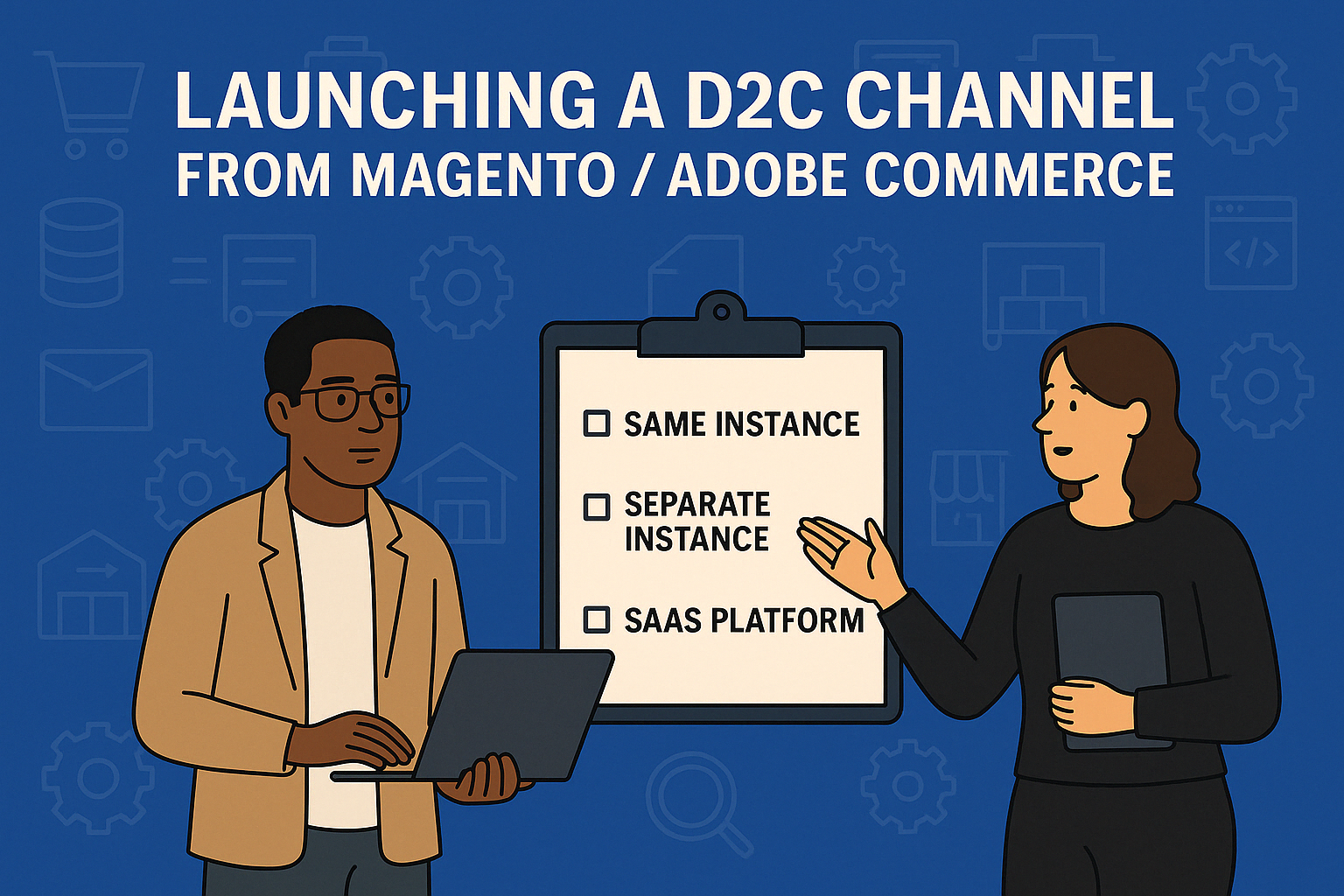What is the Best eCommerce Platform for Automotive Merchants?
We compare Magento, Adobe Commerce, BigCommerce, and Shopify in depth, examining how each caters to automotive eCommerce merchants.
4 min read
 Tim Bucciarelli
:
May 6, 2025
Tim Bucciarelli
:
May 6, 2025

Many manufacturers running Magento or Adobe Commerce for their B2B operations are now exploring direct-to-consumer (D2C) channels. Whether driven by market demand, growth strategy, or the desire to build brand awareness, D2C initiatives bring a new set of challenges—and require careful consideration of how best to extend or complement the existing eCommerce infrastructure.
There’s often a push for quick wins. Launch a new storefront. Get something live. Use a SaaS platform. But choosing the right approach for D2C isn’t just about speed or simplicity—it’s about balancing short-term goals with long-term sustainability. The decision has implications for operations, technology, customer experience, and cost of ownership.
This article outlines three common paths manufacturers take when launching a D2C channel from an existing Magento or Adobe Commerce platform. It also explores the factors that drive complexity—technical debt, architecture, data models—and why the easiest option on the surface isn’t always the best fit down the road.
For manufacturers already on Magento or Adobe Commerce, there are three primary ways to launch a D2C initiative:
Each option offers trade-offs in terms of speed, complexity, and long-term flexibility. The best choice depends on your technical foundation, internal resources, and how integrated you expect D2C to be with your existing operations.
Magento and Adobe Commerce support multiple websites, stores, and store views—all managed from a single backend. For some businesses, this makes it possible to spin up a new consumer-facing storefront using the same infrastructure that supports B2B operations.
This approach is attractive for its efficiency. Product data, inventory, customer records, and core integrations can be shared or segmented as needed. A unified system also simplifies training, support, and ongoing maintenance.
However, shared infrastructure introduces complexity. If the existing instance is already carrying technical debt or performance issues, adding a D2C channel may strain it further. Additionally, the D2C experience may require features—design flexibility, content management, simplified checkout—that don’t align well with how the B2B site is currently structured.
Magento offers several ways to configure a D2C experience:
To choose between these, you’ll need to answer questions like:
For manufacturers that want to launch a D2C channel without touching their existing Magento environment, a separate instance can offer a clean path forward. This might be appropriate when the current platform is heavily customized, already strained, or simply not designed with D2C needs in mind.
A standalone instance allows for total separation—different design, content strategy, checkout flow, and customer experience—without affecting B2B operations. It also avoids dependencies between business units, which can simplify testing and allow the D2C team to move more quickly.
This approach works well when:
Custom development and Magento hosting considerations will be key to ensuring performance and support are well planned from day one.
For some manufacturers, the fastest way to enter the D2C market is to build the new storefront on a SaaS platform like Shopify or BigCommerce. These platforms offer built-in hosting, automatic updates, and lower development overhead—making them appealing for lean teams or time-sensitive initiatives.
This route often makes sense when the D2C initiative is framed as a test or proof of concept. The business wants to validate demand, build a consumer experience from scratch, and do so without adding to the complexity of the existing Magento or Adobe Commerce environment.
This approach works best when:
Some businesses choose SaaS as a short-term option with the intention of migrating to a more integrated solution later. Others find that a separate SaaS storefront fits their needs long term—especially when the D2C channel is narrow in scope or targets a different segment altogether.
But if the D2C site succeeds and the business wants to scale, integrate, or consolidate, that early decision will need to hold up under new demands. The team should have a clear view of what migration or expansion would require—and be confident that the short-term win won’t create long-term rework.
💡 What About Just Spinning Up a Quick Shopify Site?
For many manufacturers exploring D2C, the instinct is to get something live fast. Shopify seems like a simple way to test the concept without disrupting your current Magento stack. And in some cases, that instinct is right.
If the goal is purely validation—Will this product line resonate with consumers? Can we handle fulfillment?—a lightweight Shopify setup might make sense. It’s quick, inexpensive, and self-contained.
But if there’s even a short-term vision to expand the D2C channel—adding SKUs, connecting to backend systems, or unifying customer data—this approach can create more work than it saves. You’ll end up managing two platforms, reconciling data manually, and eventually needing to rebuild the D2C site to live in a more sustainable architecture.
It’s not that Shopify is the wrong choice. It’s that “fast and separate” should be a conscious strategic decision, not just the path of least resistance. The costs come later—when short-term convenience starts to collide with long-term growth.
If your existing Magento instance is burdened by legacy customizations or deferred upgrades, building directly on top of it can slow development and increase risk. Technical debt may not stop a D2C launch, but it will shape how much effort it takes—and how reliable the outcome is.
eCommerce audits and consulting services can help identify whether your existing stack is a solid foundation or a liability.
Even if the D2C site starts separately, it will likely need to connect with shared systems and processes over time. Orders, fulfillment, and customer data must eventually sync with the rest of the business.
For manufacturers, launching a D2C channel can create tension with distributors or retail partners. Choosing a platform that supports differentiated experiences—and a clear strategy for managing pricing and availability across channels—can help reduce friction.
The best D2C platform approach isn’t always the fastest or cheapest. It’s the one that fits your business goals, technical landscape, and capacity to manage change. With that clarity, platform decisions become strategic—not reactive.

We compare Magento, Adobe Commerce, BigCommerce, and Shopify in depth, examining how each caters to automotive eCommerce merchants.
.png)
eCommerce expert Aaron Sheehan from BigCommerce breaks down the key advantages and disadvantages of BigCommerce, Magento, Shopify, and WooCommerce.

IronPlane recently conducted interviews with eCommerce experts on the topic of the future of eCommerce. This post highlights the six key ideas raised in our conversations.